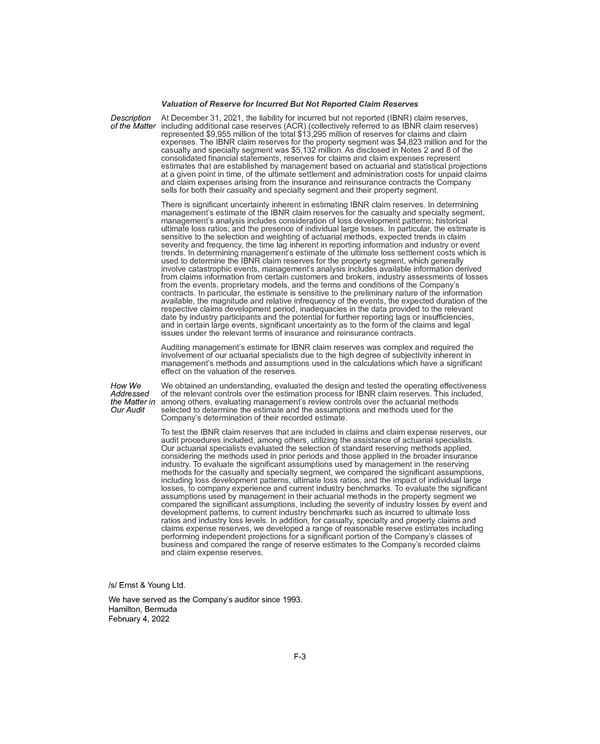Valuation of Reserve for Incurred But Not Reported Claim Reserves Description of the Matter At December 31, 2021, the liability for incurred but not reported (IBNR) claim reserves, including additional case reserves (ACR) (collectively referred to as IBNR claim reserves) represented $9,955 million of the total $13,295 million of reserves for claims and claim expenses. The IBNR claim reserves for the property segment was $4,823 million and for the casualty and specialty segment was $5,132 million. As disclosed in Notes 2 and 8 of the consolidated financial statements, reserves for claims and claim expenses represent estimates that are established by management based on actuarial and statistical projections at a given point in time, of the ultimate settlement and administration costs for unpaid claims and claim expenses arising from the insurance and reinsurance contracts the Company sells for both their casualty and specialty segment and their property segment. There is significant uncertainty inherent in estimating IBNR claim reserves. In determining management’s estimate of the IBNR claim reserves for the casualty and specialty segment, management’s analysis includes consideration of loss development patterns; historical ultimate loss ratios; and the presence of individual large losses. In particular, the estimate is sensitive to the selection and weighting of actuarial methods, expected trends in claim severity and frequency, the time lag inherent in reporting information and industry or event trends. In determining management’s estimate of the ultimate loss settlement costs which is used to determine the IBNR claim reserves for the property segment, which generally involve catastrophic events, management’s analysis includes available information derived from claims information from certain customers and brokers, industry assessments of losses from the events, proprietary models, and the terms and conditions of the Company’s contracts. In particular, the estimate is sensitive to the preliminary nature of the information available, the magnitude and relative infrequency of the events, the expected duration of the respective claims development period, inadequacies in the data provided to the relevant date by industry participants and the potential for further reporting lags or insufficiencies, and in certain large events, significant uncertainty as to the form of the claims and legal issues under the relevant terms of insurance and reinsurance contracts. Auditing management’s estimate for IBNR claim reserves was complex and required the involvement of our actuarial specialists due to the high degree of subjectivity inherent in management’s methods and assumptions used in the calculations which have a significant effect on the valuation of the reserves. How We Addressed the Matter in Our Audit We obtained an understanding, evaluated the design and tested the operating effectiveness of the relevant controls over the estimation process for IBNR claim reserves. This included, among others, evaluating management’s review controls over the actuarial methods selected to determine the estimate and the assumptions and methods used for the Company’s determination of their recorded estimate. To test the IBNR claim reserves that are included in claims and claim expense reserves, our audit procedures included, among others, utilizing the assistance of actuarial specialists. Our actuarial specialists evaluated the selection of standard reserving methods applied, considering the methods used in prior periods and those applied in the broader insurance industry. To evaluate the significant assumptions used by management in the reserving methods for the casualty and specialty segment, we compared the significant assumptions, including loss development patterns, ultimate loss ratios, and the impact of individual large losses, to company experience and current industry benchmarks. To evaluate the significant assumptions used by management in their actuarial methods in the property segment we compared the significant assumptions, including the severity of industry losses by event and development patterns, to current industry benchmarks such as incurred to ultimate loss ratios and industry loss levels. In addition, for casualty, specialty and property claims and claims expense reserves, we developed a range of reasonable reserve estimates including performing independent projections for a significant portion of the Company’s classes of business and compared the range of reserve estimates to the Company’s recorded claims and claim expense reserves. /s/ Ernst & Young Ltd. We have served as the Company’s auditor since 1993. Hamilton, Bermuda February 4, 2022 F-3
 2021 Annual Report Page 145 Page 147
2021 Annual Report Page 145 Page 147